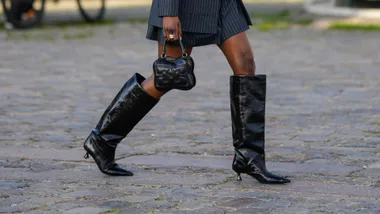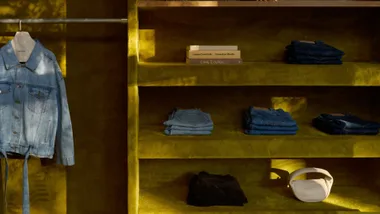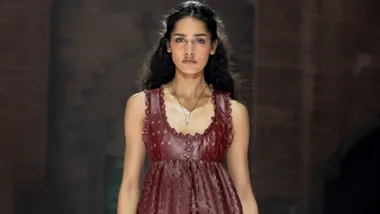We all know the term, ‘fast fashion’, but do we really know what it means?
Of course, we quickly associate it with something bad—from its detrimental contribution to the climate crisis to its unethical production standards.
But what exactly is fast fashion? To put it simply, the term references cheap, trend-driven clothes and accessories that often reference major designers collections or celebrity culture, they are made in high volumes and at low cost which makes them readily available for a fraction of the price of the original.

How does this impact the fashion industry and the environment?
While clothing started out as something humans wore out of necessity, throughout history they became so much more than that. People quickly realised the power of clothes, whether it be a status symbol or form of self-expression, dating right back to the middle ages and throughout the last century.
However, fashion used to be a slow industry. Designs were drawn, materials were sourced (or often made) and the garments were then created, often by hand. But as time went on, with the industrial revolution and as technology advanced, this made sourcing/creating materials and labour easier, cheaper and faster and by the 1960s and 70s fashion had started to become more accessible – and affordable – to the masses.
Then in the last two decades, with the rise of social media and online shopping, a new fashion industry has been born, and it what has become known as ‘fast fashion’.
What is Fast Fashion?
With global retailers such as H&M, Topshop and Zara churning out clothes faster than the major designers can send the trends down the runway – and for a fraction of the cost, they opened up fashion to a whole new consumer who could suddenly express their thirst for fashion and the desire to be on trend.
While the fashion industry was once an exclusive club, dominated by the elite and the wealthy, these days anyone, anywhere in the world need only lust over a collection as it comes down the runway for mere minutes, before they can shop the look for a fraction of the price.
But at what cost does fast fashion come?
The impact of fast fashion on the planet is immense. And hugely concerning. With the fashion industry reported as the second largest polluter after the oil industry, fast fashion fuels this through the use of cheap and toxic textiles as well as damaging practices along the supply and delivery chains.
And it’s not just the retailers, it’s us, the consumers too. As quickly as we’re buying the clothes, we’re also throwing them out. No longer is there a mentality of ‘keeping something forever’. Fashion has become disposable, we wear something once (or a handful of times) before discarding it.
ABC’s War on Waste reports that it takes 2,700 litres of water to make one cotton T-shirt, which is enough for one person to drink for 900 days. Us Aussies alone are disposing of 6,000 kilograms of fashion and textile waste every 10 minutes.
Not to mention the ethical cost of fast fashion, the workers making the clothes and along the supply chain, often underpaid and in unsafe working conditions.
RELATED: All Of The Sustainable Fashion Brands You Need To Know
How do you define a fast fashion brand?
While there are a number of bigger global names we all know who are running the fast fashion race, there are also more and more emerging all the time, so how do you know who they are?
Some telling signs, according to goodonyou.com include:
- Thousands of styles, which touch on all the latest trends.
- Extremely short turnaround time between when a trend or garment is seen on the catwalk, or in celebrity media, and when it hits the shelves.
- Offshore manufacturing where labour is the cheapest, with the use of workers on low wages without adequate rights or safety, as well as complex supply chains with poor visibility beyond the first tier and of subcontracting.
- Limited quantity of a particular garment – this is an idea pioneered by Zara. With new stock arriving in store every few days, shoppers know if they don’t buy something they like they’ll probably miss their chance.
- Cheap, low-quality materials, where clothes degrade after just a few wears and get thrown away.
Who are the major fast fashion brands?
Global juggernauts such as Zara, H&M and Topshop, UNIQLO and GAP are no doubt running the fast fashion game and have been for some time, but the likes of Missguided, Forever 21, Zaful, Boohoo and Fashion Nova have come along and are making fashion faster than ever before.
Attitudes are changing
Thankfully, we’re wising up to the vast impact fast fashion has on the environment, and consumers are starting to hold brands accountable for their carbon footprint and how they produce their items. A shift is happening and a movement back to ‘slow fashion’ is on the rise, with more and more consumers questioning, how, where and of what the products they are buying is made—and ensuring those making them are being treated fairly. Despite still having a long way to go, it’s a start.
What can you do?
Avoid fast fashion brands (or only shop their eco/sustainable/ethical collections), invest your money in brands that are making their clothes in a sustainable and ethical way. Invest in clothes that will last and you will keep wearing season after season.
Get informed! If you want to check what a brand is doing, jump on their website and read what they have to say—or you can download the GoodOnYou app, which allows you to search brands that they have rated based on criteria such as how they treat their workers, the environmental impact and animals and covers both local and international brands—including some of the world’s leading retailers.
Ethical Clothing Australia provides information on Aussie brands who produce their garments ethically and you can follow Instagram accounts such as Fashion Revolution and Ethical Fashion AU to stay up to date and informed on the industry.
You can also make a conscientious effort to re-wear the clothes you already own — after all, you bought them for a reason.
To help combat the clothing crisis, Vanish Australia has announced a goal to divert one million clothing items from landfill over the next two years to help #MakeTextileWasteVanish. Partnering with textile upcycler Upparel, the initiative aims to educate Australians on how to help reduce textile waste by prolonging the life cycle of clothes through better care and re-wear. This includes properly caring for your clothes can help prolong the life of garment, repairing damaged clothes or styling old outfits to give them a second life.










